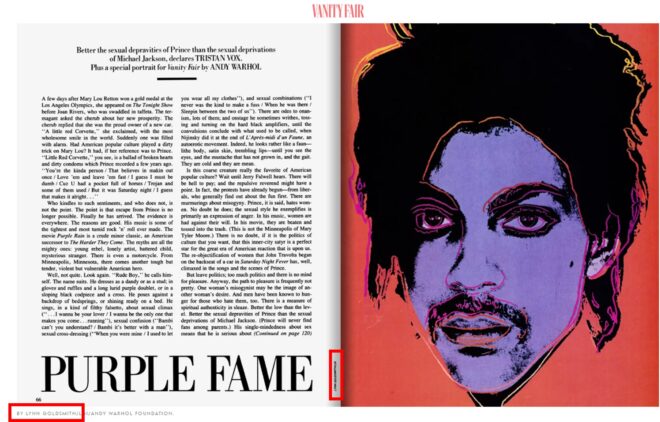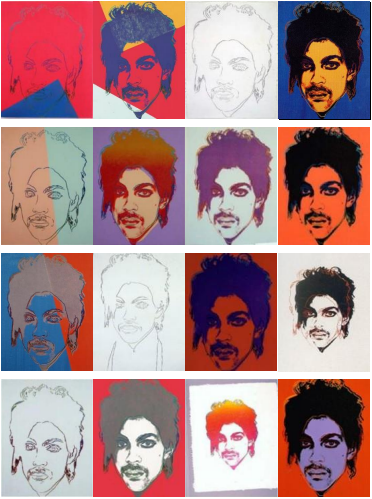These were the hot topics in the recently decided Supreme Court case of Andy Warhol Foundation for the Visual Arts, Inc. v. Goldsmith et al., 598 U.S. ____ (2023) (Citations are to the Slip Opinion (“Slip Op.”)).
Money and copyright won by a 7-2 majority. Warhol and his Foundation’s claim of fair use lost. Prince was unaffected, may he rest in purple peace.
The case began after Prince died in 2016, when Vanity Fair magazine’s parent company, Condé Nast, published a special commemorative magazine celebrating his life. For the cover art, Condé Nast paid the Andy Warhol Foundation (“AWF”) more than $10,000 to use a Warhol painting of Prince known as “Orange Prince:”

2016 Condé Nast Cover
The painting was one of 16 works Warhol made in 1984, after Prince released his album “Purple Rain.” It—and the whole “Prince Series”—was based on a photograph taken by the photographer Lynn Goldsmith in 1981:

Goldsmith’s Original 1981 Photograph
Goldsmith, an award-winning photographer well known for her portraits of famous musicians, received no money or credit for the 2016 use of Warhol’s painting, although in the 1980s she had been paid $400 by Vanity Fair for a limited license for use of one of her Prince photos as an “artist reference for an illustration.” The license provided that the use would be for “one time” only. Vanity Fair commissioned Warhol to create the illustration, and Warhol used Goldsmith’s licensed photo to create a purple silkscreen portrait of Prince, which appeared with an article about Prince in Vanity Fair’s November 1984 issue. The magazine credited Goldsmith for the “source photograph:”

1984 Article, which had two Lynn Goldsmith attributions.
After Prince died in 2016, Condé Nast asked AWF about reusing the 1984 Warhol purple silkscreen, but after learning that there were other works in Warhol’s Prince Series, it opted instead to purchase a license from AWF to publish Orange Prince. Goldsmith did not know about the Prince Series until 2016, when she saw Orange Prince on the cover of Condé Nast’s magazine. Goldsmith notified AWF of her belief that the work infringed her copyright. AWF then sued Goldsmith in the Southern District of New York for a declaratory judgment of noninfringement. Goldsmith counterclaimed for copyright infringement.
The District Court considered the four fair use factors set forth in 17 U.S. C. §107, and granted summary judgment for AWF on its defense of fair use. The Second Circuit reversed, finding that all four fair use factors favored Goldsmith. The Supreme Court affirmed the Second Circuit, holding that the first fair use factor, “the purpose and character of the use, including whether such use is of a commercial nature or is for nonprofit educational purposes,” §107(1), weighed against AWF’s fair use defense to copyright infringement because the Condé Nast-AWF license constituted “commercial licensing.”
The SDNY litigation focused on whether Warhol had “transformed” Goldsmith’s photograph. A transformative work is fair use, and therefore not a copyright infringement, based on a reading of the Supreme Court’s holding in Campbell v. Acuff-Rose Music, Inc., 510 U.S. 569 (1994), which explained that a work is transformative if it “adds something new, with a further purpose or different character, altering the first with new expression, meaning or message.” AWF argued that the paintings were “transformative works,” not copyright infringement, because “Warhol added layers of bright and unnatural colors, conspicuous hand-drawn outlines and line screens, and stark black shading that exaggerated Prince’s features. The result in all the Prince Series works is a flat, impersonal, disembodied, mask-like appearance.” Brief For Petitioner at 19 (June 10, 2022).

Warhol’s Prince Series, from AWF’s Appendix (JA 505-06).
In its opinion, the Supreme Court expounded on the first fair use factor, “the purpose and character of the use, including whether such use is of a commercial nature or is for nonprofit purposes, considers the reasons for, and nature of, the copier’s use of an original work. The central question it asks is whether the use ‘merely supersedes the objects of the original creation… (supplanting the original), or instead adds something new, with a further purpose or different character’” Slip Op., at 2-3 (Syllabus), citing Acuff-Rose, 510 at 579.
“The commercial nature of a use is relevant, but not dispositive,” the opinion states. Slip Op., at 18. “It is to be weighed against the degree to which the use has a further purpose or different character. Second, the first factor relates to the justification for the use. In a broad sense, a use that has a distinct purpose is justified because it furthers the goal of copyright, namely, to promote the progress of science and the arts, without diminishing the incentive to create. In a narrower sense, a use may be justified because copying is reasonably necessary to achieve the user’s new purpose.” Id.
“In sum, if an original work and secondary use share the same or highly similar purposes, and the secondary use is commercial, the first fair use factor is likely to weigh against fair use, absent some other justification for copying.” Id. (Syllabus) at 4.
Money (and Goldsmith) won because the Court emphasized the fact that both Warhol and Goldsmith were engaged in the commercial enterprise of licensing images of Prince to magazines. “Such licenses, for photographs or derivatives of them, are how photographers like Goldsmith make a living. They provide an economic incentive to create original works, which is the goal of copyright.” Slip Op., at 22. “To hold otherwise would potentially authorize a range of commercial copying of photographs, to be used for purposes that are substantially the same as those of the originals. As long as the user somehow portrays the subject of the photograph differently, he could make modest alterations to the original, sell it to an outlet to accompany a story about the subject, and claim transformative use.” Id. at 33.
Copyright won, maybe, because the Court emphasized copyright holders’ right to create (or license) derivative works, which inherently increases the amount of transformation needed for a work to shift from a derivative work to a transformative work: “Goldsmith’s original works, like those of other photographers, are entitled to copyright protection, even against famous artists. Such protection includes the right to prepare derivative works that transform the original.” Slip Op., at 38. “[A]n overbroad concept of transformative use, one that includes any further purpose, or any different character, would narrow the copyright owner’s exclusive right to create derivative works. To preserve that right, the degree of transformation required to make ‘transformative’ use of an original must go beyond that required to qualify as a derivative.” Id. at 16.
This is the most significant change from Campbell: Many courts after Campbell held that if a work was truly transformative, the work was fair use; battles waged over whether works were transformative. Thus, AWF (and Warhol) lost because, in the Court’s reasoning, “Campbell cannot be read to mean that §107(1) weighs in favor of any use that adds new expression, meaning, or message. Otherwise, ‘transformative use’ would swallow the copyright owner’s exclusive right to prepare derivative works, as many derivative works that “recast, transfor[m] or adap[t]” the original, §101, add new expression of some kind.” Id. at 28.
The concurring opinion, written by Justice Kavanagh and joined by Justice Jackson, focused on how to interpret the first fair-use factor, finding that it “requires courts to assess only whether the purpose and character of the challenged use is the same as a protected use. And here, the undisputed facts reveal that the Foundation sought to use its image as a commercial substitute for Ms. Goldsmith’s photograph.” Concurrence at 4. This interpretation differs from that argued by AWF:
On the Foundation’s telling, the statute requires courts to focus on the purpose the creator had in mind when producing his work and the character of his resulting work. So what matters in this case is that Andy Warhol intended to apply a "new aesthetic" to Lynn Goldsmith’s photograph and the character of his work "transformed" Prince from the "vulnerable, uncomfortable person" depicted in Ms. Goldsmith’s photograph into "an iconic, larger-than-life figure." Because the purpose and character of Mr. Warhol’s work is so different from Ms. Goldsmith’s, the Foundation insists, the first statutory factor points in favor of finding a fair-use affirmative defense.
Id. at 1
After closely examining the language of the statute, the concurrence continues “under the first fair-use factor the salient point is that the purpose and character of the Foundation’s use involved competition with Ms. Goldsmith’s image. To know that much is to know the first fair-use factor favors Ms. Goldsmith.” Id. at 4. Justice Kavanagh continued by thoroughly endorsing the majority opinion:
With all this in mind, the Court’s decision seems to me exactly right. Does Mr. Warhol’s image seek to depict Prince as a “larger-than-life” icon while Ms. Goldsmith’s photograph attempts to cast him in a more “vulnerable” light? Or are the artistic purposes latent in the two images and their aesthetic character actually more similar than that? Happily, the law does not require judges to tangle with questions so far beyond our competence. Instead, the first fair-use factor requires courts to assess only whether the purpose and character of the challenged use is the same as a protected use. And here, the undisputed facts reveal that the Foundation sought to use its image as a commercial substitute for Ms. Goldsmith’s photograph.
Concurrence at 4
Concluding the concurrence, Justice Kavanagh noted that the Court’s majority opinion was narrow: “This case does not call on us to strike a balance between rewarding creators and enabling others to build on their work. That is Congress’s job.” Moreover, he noted “The Court today does not even decide whether the Foundation’s image of Prince infringes on Ms. Goldsmith’s copyright.” The Court simply affirmed the Second Circuit’s holding (reversing the District Court’s grant of summary judgment for AWF), which was “focused primarily on the district court’s ‘application of the four fair-use factors.’ 11 F. 4th 26, 32 (2021). And this Court granted review to decide only the question of fair use and only the role of a single factor in that affirmative defense.” Concurrence at 6.
Finally, Justice Kavanagh noted that fair use may have applied in this case had “the Foundation [] sought to display Mr. Warhol’s image of Prince in a nonprofit museum or a for-profit book commenting on 20th-century art, [because] the purpose and character of that use might well point to fair use. But those cases are not this case. Before us, Ms. Goldsmith challenges only the Foundation’s effort to use its portrait as a commercial substitute for her own protected photograph in sales to magazines looking for images of Prince to accompany articles about the musician. And our only point today is that, while the Foundation may often have a fair-use defense for Mr. Warhol’s work, that does not mean it always will. Under the law Congress has given us, each challenged use must be assessed on its own terms.” Id.
In her dissent, Justice Kagan, joined by Chief Justice Roberts, wrote that the decision “will stifle creativity of every sort. It will impede new art and music and literature,” she wrote. “It will thwart the expression of new ideas and the attainment of new knowledge. It will make our world poorer.” Dissent, at 36. Justice Sotomayor sharply criticized the dissent, stating that it set forth “a series of misstatements and exaggerations, from the dissent’s very first sentence to its very last.” Slip Op., at 21 fn. 10.
Justice Kagan asserted that the majority wholly failed to appreciate Warhol’s art, which was the thrust of AWF’s brief in support of its “transformative” work argument: “Goldsmith is asking for something remarkable here: She wants the Court to hold that the works of Andy Warhol—universally recognized as a creative genius who pioneered the twentieth century Pop Art movement—are not transformative, and therefore are illegal. Moreover, she wants the Court to reach that conclusion based on a novel legal theory—and on a record where no one disputes that Warhol conveyed something unique and distinct from his underlying source material. If Warhol’s degree of creative transformation cannot even satisfy the first fair-use factor, little remains of the fair-use defense for artistic works.” Reply Brief For Petitioner at 1 (dated September 7, 2022).
“The majority does not see it,” Justice Kagan wrote. “And I mean that literally. There is precious little evidence in today’s opinion that the majority has actually looked at these images, much less that it has engaged with expert views of their aesthetics and meaning.” Dissent at 17. She continued, “Suppose you were the editor of Vanity Fair or Condé Nast, publishing an article about Prince. You need, of course, some kind of picture. An employee comes to you with two options: the Goldsmith photo, the Warhol portrait. Would you say that you don’t really care? That the employee is free to flip a coin? In the majority’s view, you apparently would.” Id. at 10.
One may argue that the dissent treats the copyright holder’s right to make derivative works too narrowly. As noted by the Second Circuit in the Rogers v. Koons case, 960 F.2d 301 (2d Cir. 1992), copyright holders are entitled to re-create their works in different mediums (such as turning a photo into a silkscreen or painting or sculpture). While that case involved a putative parody of a photograph in the form of a 3-dimensional sculpture, the SDNY, whose opinion was affirmed by the Court of Appeals, noted that “[u]nder the plain wording of the statute, Koons’ sculpture is a derivative work based upon Rogers’ photograph; and Rogers as copyright owner had the exclusive right to authorize derivative work. It is well settled that a photographer’s originality in photographic expression is entitled to full copyright protection.” 751 F. Supp. 474, 477 (S.D.N.Y. 1990).
The defendant in that case, Jeff Koons, was, like Warhol, an internationally successful and well-known artist. He found a photo on a postcard of two people holding puppies, and he wanted to make a sculpture based on it for an art show on the theme of “banality.” After removing the copyright label from the postcard, he gave it to his assistants with instructions on how to model the sculpture. He asked that as much detail be copied as possible, though he changed the color of the puppies to blue, exaggerated their noses, and added flowers to the hair of the man and woman holding the puppies. The sculpture was a success. Koons sold three of them for a total of $367,000. Upon discovering that his picture had been copied, the photographer, Rogers, sued Koons and his gallery for copyright infringement. Koons admitted to having copied the image intentionally, but attempted to claim fair use by parody. The Court found copyright infringement based on “substantial similarity” between the photo and sculpture, and Koons’ access to the picture. On the issue of fair use, the court rejected the parody argument. Id.
Indeed, it was Goldsmith’s intent in this case to bolster artists’ derivative rights and to narrow the definition of fair use. In a recent interview with WWD magazine, Goldsmith said “her…aim was to tighten up fair use or transformative aspects of the law. ‘It doesn’t mean that an artist isn’t influenced by another artist’s work. But if you are going to take something, … ask permission. It’s that simple.’” .
The Court can be viewed as ignoring the importance of transformative works, especially where the works are not of a commercial nature, or competitive with the original works.
On the other hand, it may be argued that the Court did not ignore the importance of transformative works, but it found that the purpose of the allegedly transformative work must be considered along with its “new expression, meaning or message.” Justice Sotomayor noted that “[i]n a broad sense, a use that has a distinct purpose is justified because it furthers the goal of copyright, namely, to promote the progress of science and the arts, without diminishing the incentive to create. Slip Op. at 18. However, “[a] use that shares the purpose of a copyrighted work, by contrast, is more likely to provide ‘the public with a substantial substitute for matter protected by the [copyright owner’s] interests in the original wor[k] or derivatives of [it],’ which undermines the goal of copyright.” Id. at 19. [Internal citations omitted.]
“In sum, the first fair use factor considers whether the use of a copyrighted work has a further purpose or different character, which is a matter of degree, and the degree of difference must be balanced against the commercial nature of the use. If an original work and a secondary use share the same or highly similar purposes, and the secondary use is of a commercial nature, the first factor is likely to weigh against fair use, absent some other justification for copying.”
Id. at 19-20
Justice Sotomayor criticized the dissent for “assum[ing] that any and all uses of an original work entail the same first-factor analysis based solely on the content of a secondary work. This assumption contradicts the fair use statute and this Court’s precedents. Had AWF’s use been solely for teaching purposes, that clearly would affect the analysis, and the statute permits no other conclusion.” Id. at 21 fn. 10.
The dissent would rather not debate these finer points. It offers no theory of the relationship between transformative uses of original works and derivative works that transform originals. No reason why AWF was justified in using Goldsmith’s original work in this specific instance. And no limiting principle for its apparent position that any use that is creative prevails under the first fair use factor. … It will not impoverish our world to require AWF to pay Goldsmith a fraction of the proceeds from its reuse of her copyrighted work. Recall, payments like these are incentives for artists to create original works in the first place.
Slip Op. at 36
In light of the proliferation of transformative works, it will be interesting to see what transformative artists do going forward. If Goldsmith has truly achieved her greater goal, more copyright holders will get compensated for their original works by putative transformative artists. Or, transformative artists may be stifled or, as Warhol could have done, hire someone to take a photograph or license a stock photograph for a tuppence.